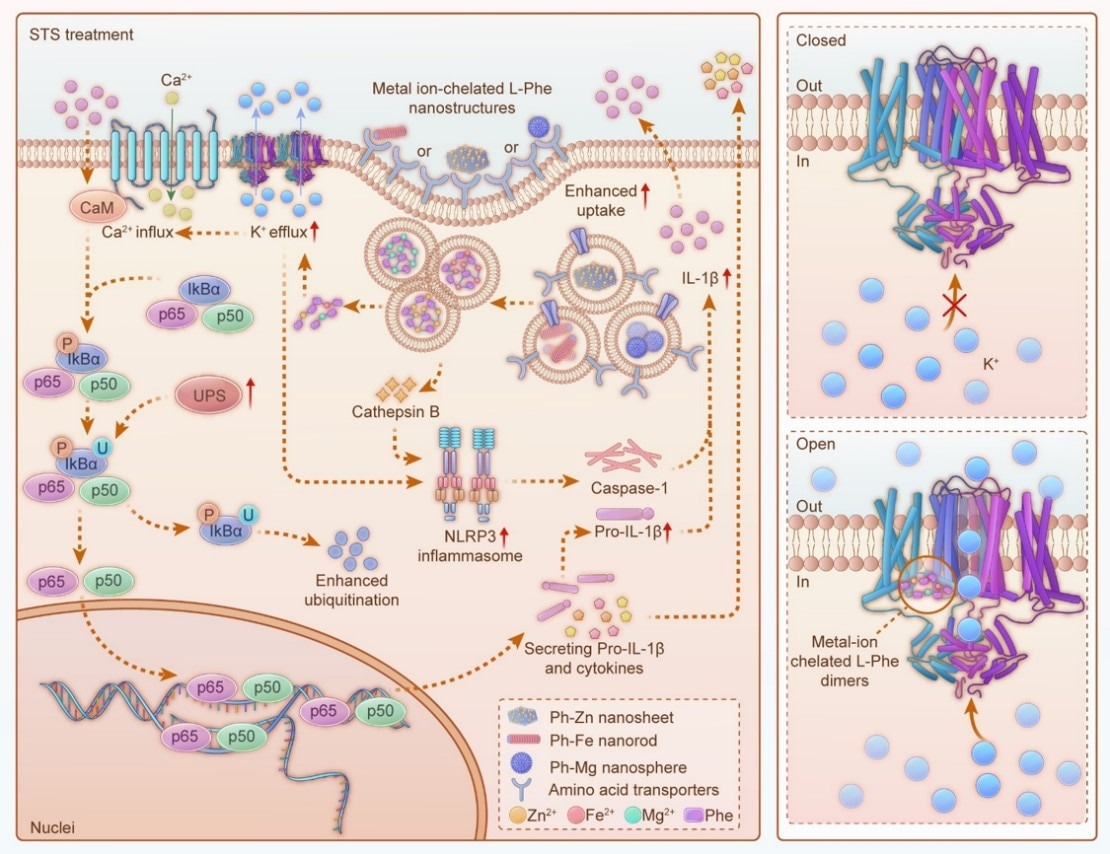Reviewed by Lexie CornerAug 30 2024
A research team from the National Center for Nanoscience and Technology of the Chinese Academy of Sciences, in collaboration with Chongqing Medical University, has developed three types of nanostructures that combine L-phenylalanine with metal ions. The study has been published in the journal Nature Nanotechnology.
 Schematic illustration of enhanced tumor immunotherapy using DC therapy mediated by metal ion-chelated L-phenylalanine nanocomplexes. Image Credit: Prof. Hai Wang et al.
Schematic illustration of enhanced tumor immunotherapy using DC therapy mediated by metal ion-chelated L-phenylalanine nanocomplexes. Image Credit: Prof. Hai Wang et al.
Tumor immunotherapy includes immune checkpoint blockade (ICB) as a central technique. Clinical evidence, however, indicates that not all patients benefit from ICB therapy. A key challenge in cancer immunotherapy is overcoming the tumor's immunosuppressive microenvironment. By modifying this environment, researchers aim to enhance the effectiveness of ICB therapy.
A research team led by Professors Hai Wang and Guangjun Nie from the National Center for Nanoscience and Technology of the Chinese Academy of Sciences, in collaboration with Professor Haitao Ran from Chongqing Medical University, has made significant progress in addressing this issue. Their novel design alters the tumor's immune-suppressive environment, greatly enhancing the efficacy of ICB immunotherapy.
Dendritic cells (DCs) play a vital role in the immune system's defense against infections and cancer, as the activation of tumor-specific immunity depends on the maturation of DCs. Over the past decade, it has been established that DC maturation and the subsequent immune response are triggered primarily by pathogen-associated molecular patterns (PAMPs) and damage-associated molecular patterns (DAMPs).
However, the body's electrical signals, particularly the concentration of calcium and potassium ions within DCs, also significantly influence DC functions, including maturation, cytokine production, and migration.
Ion channels strictly regulate the flow of metal ions into and out of cells, and until now, there has been no reliable method for activating these channels. To address this, the researchers used a combination of magnesium, iron, and zinc ions with L-phenylalanine to open the potassium ion channels on the DC membrane, resulting in the formation of three distinct nanostructures: Ph-Mg nanospheres, Ph-Fe nanoneedles, and Ph-Zn nanosheets.
The researchers discovered that although these nanomaterials could enter cells by caveolae-mediated endocytosis and pinocytosis, they were unstable in acidic environments.
. Computer simulations suggested that the disassembled nanostructures would release metal ion-chelated L-phenylalanine dimers. These dimers can bind to the S4 transmembrane region of the Kv1.3 potassium ion channel, altering its structure to widen and activate the channel. This leads to potassium ion outflow and calcium ion inflow, which depolarizes the cell membrane and activates the calmodulin-regulated NF-κB signaling pathway, promoting DC maturation and the release of pro-inflammatory cytokines.
Currently, most protein regulation focuses on developing inhibitors. Finding ways to activate protein functions is still challenging. Fortunately, we discovered that using nanomedicine can precisely activate the Kv1.3 potassium ion channel in DCs. This activation reverses the tumor's immune-suppressive environment and enhances the effectiveness of immune checkpoint inhibitors.
Hai Wang, Professor and Study Lead Author, Chinese Academy of Sciences
By modifying the potassium and calcium ions in DCs, this research creates metal ion-amino acid nanostructures that can control ion channel structures and enhance the activation of the innate immune response. This alters the immune-suppressive milieu of the tumor and offers a fresh approach to enhancing the efficacy of ICB therapy.
Journal Reference:
Tan, M., et al. (2024) Metal-ion-chelating phenylalanine nanostructures reverse immune dysfunction and sensitize breast tumor to immune checkpoint blockade. Nature Nanotechnology. doi.org/10.1038/s41565-024-01758-3